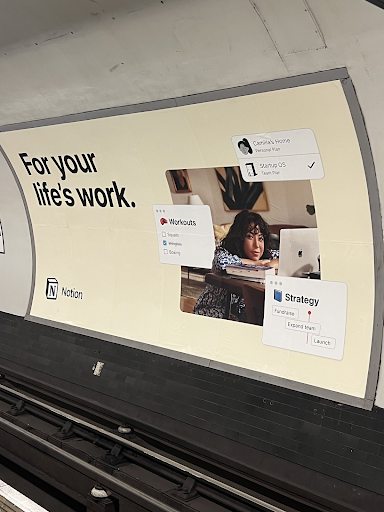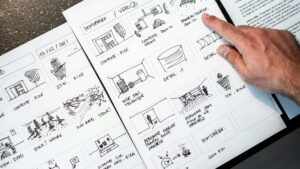How do you get an idea out of your head and into the world?
- Do you write it down?
- Draw a diagram?
- Perform it via the medium of interpretive dance? (our ideal method, obviously) 🕺
But what if it’s something more abstract and difficult to express, like the product strategy framework of a digital product?
Regular readers will remember that in a recent article we ran through a fair few methods for breaking away from a’ business as usual’ (BAU) mindset. In it, we plumped for creating a product vision (also known as a visiontype) as our favourite way to help organisations make bold changes.
It turns out there’s a lot more to say about this than we had space for there, so we thought it best to expand and give it a whole article of its own.
It also turns out it’s much more effective than interpretive dance when it comes to sharing a product team’s idea of the future. Best put the leotard away.
What even is a product vision?
Many of us are familiar with setting out a vision for a business, whereby stakeholders articulate where they aspire to the organisation being in three (or five or ten or whatever) years’ time.
It’s pretty simple to get this clear in your mind since the business is a known quantity and an easy thing to conceptualise.
However, when it comes to the future of a product, there is a greater need to graphically ‘show, not tell’ in order to align everyone on the same page. This is where a well-defined product strategy framework can play a crucial role in guiding the vision.
Why create one?
As we mentioned earlier, a product vision is an excellent way to break away from the stagnation associated with BAU. But that’s not all it’s good for.
- New markets are beckoning, and exploration around how to capture new user types without alienating existing ones is needed.
- Morale is flagging, with siloed departments needing to be unified and understand their collective purpose.
- A competitor has emerged where there was once none, and your product needs to self-disrupt before it’s overtaken by this plucky interloper.
- An acquisition or merger necessitates that products integrate, sunset, or streamline at some point.
- An investment round or budget request is on the horizon, and stakeholders are eager to be impressed.
In each of these scenarios, leveraging a product strategy framework can help clarify objectives and ensure alignment across teams.
Scaling new heights: 4 tips for launching your product in a new market
Launching in a new market can be tougher than you’d think, so we’ve shared some tips to help 💪
How ambitious should we be?

Your vision is the north star, not the next iteration.
It shouldn’t be constrained by what’s possible in the present or near future, or form part of the BAU work a product team gets up to.
At the same time, however, it shouldn’t be rooted in abject fantasy. A vision that is far removed from any conceivable reality may excite some, but it will alienate anyone who isn’t blinded by the bright lights.
There’s a balance to be struck, and a product strategy framework can help maintain that balance by outlining realistic yet aspirational goals.
Try not to worry too much about the nitty gritty of how the vision will come to fruition. The vision exists to communicate a possible future; working out how to get there can come later if there’s appetite for it.
What format does a product vision take?
A product vision is an outcome in and of itself that asks its audience “should we do this?”
So depending on the nature of the product and organisation, its actual shape could vary quite a bit. From a polished video with animations and narration made to dazzle to an interactive prototype.
For a highly technical data product, a product team might even showcase value through a clickable dummy data set, delving deep into one specific area of functionality.
Ultimately, it’s about what communicates best, and a product strategy framework can guide the selection of the most effective format.
It’s important to note too that whilst there’s likely to be a fair bit of design work involved, what’s happening here isn’t actually UX design. It’s something more iconic and simplified.
The product vision is intended to provide value by communicating, not by being a rigorously tested and user validated candidate for launch.
For example, a product vision that showed the ability to log out of an application or to authenticate a user wouldn’t generate a lot of excitement. They’re the basics, not the stuff of anyone’s product dreams.
Conversely, a product that neglects such crucial features would be an obvious disaster.
This is the crucial difference. In a sense, the product vision bridges the gap between advertising and product design.

Consider the ads we’ve been spotting in tube stations for our favourite collaboration tool Notion.
In seeing the simplified snippets and context shown we understand the product’s purpose better than if we were looking at the actual interface.
We might also look to Apple’s 1987 Knowledge Navigator video for a bit of inspiration on how ambitious – yet grounded in reality- a product vision might be.
Fun fact: We see elements of HyperCard, arguably the most influential now-obsolete Apple invention, reflected here.
Despite the fact we aren’t sticking anything to the walls or living with a sentient Filofax, as the Apple video star appears to, the communication of the concept resounds in our product vision work.
The well-executed product vision

Despite the various forms and appearances a product vision might take, successful ones share a few common characteristics:
- They have boundaries set at the start. The sweet spot between feasibility and futurism has been identified, and the desired outcomes—be it ‘impressing investors’ or ‘engaging different departments’—have been clearly defined.
- They’re well-researched. A vision rooted in actual user needs is always more powerful than one that is merely the dream of a product team.
- They tell a story. UI assets alone cannot always convey the entire message. This ties back to effective communication, articulating what’s happening rather than presenting a collection of aesthetically pleasing screens that simply ask, “Do you like this?” Not very compelling!
A well-defined product strategy framework can enhance storytelling by ensuring that the vision resonates with the target audience’s needs and aspirations.
A product vision that succeeds is one that gets people talking, thinking, and planning about the ideas presented with energy and enthusiasm… all without the interpretive dancer’s need for lycra.